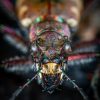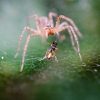
The House fly (Musca domestica) – belongs to the suborder Cyclorrhapha. Its origin was in the Cenozoic era. But you can find the house fly in all parts of the globe in various sizes and shapes. They tend to be common in Indian households. When they find a suitable environment, house flies grow in number. To have a complete house fly control, you should know the size, seasonality, life cycle and habits. Only a experienced house fly control professional can suggest the proper control methods. This article gives information on everything you need to know about house fly.
1. House Fly Lifespan
Usually, the adult has a lifespan of thirty days. The growth stages consist of egg, larva, pupa and the last is adult stage.
2. House Fly Facts
The adult has a grey thorax along with narrow stripes. It has compound eyes with lenses numbering a thousand to have a wide vision.
3. What Do You Know About House Fly Life Cycle?
The house fly, like other living beings, has two genders, male and female. In one batch, a female can lay about 75 to 150 eggs. During its house fly life cycle, a female has the ability to lay 500 eggs. The eggs are usually white in color. The female house fly usually deposits the eggs on dead, decaying matter such as faeces or food waste.
The hatching of eggs happens in quick succession. The larvae develop to pupae in less than two weeks if conditions are favorable. But in cool environment, they may take thirty days. The house fly larvae detest lights of all kinds and usually live in animal manure. Their favorite growth condition should be warm, dark and moist.
Metamorphosis
The transition from a pupae to an adult takes two to six days at a favorable temperature of 35 degree celsius. If the environment is cool, then the duration taken for the house fly pupae to become an adult will be twenty days.
The adult fly emerges from the pupae, the last stage of metamorphosis. Usually, their life span is 15 days to a month.
4. Know About House Fly Activity
They can cause disturbances in the daily activities of the house or any place. Their very presence signals a aura of distrust and disease. House flies can survive in any temperature, climate and landform. The main reason, they can feed on anything under the sun and darkness. They can consume rotten flesh to animal droppings to drainage sludge. A house fly seldom moves after dusk. You can find them in rest mode on ceiling fans, fences, windows, grass, buildings and outdoor wires. Do you live in a house fly infestation area? Then you need the advice of a pest control company. The experienced house fly control experts will adopt stringent measures for complete eradication. This is one of the major points you need to know about house fly.
5. House Fly Eggs – Signs of a House Fly Infestation
The house fly adults – they are hypertensive when in search of food. The female deposits eggs in the most unlikely places such as garbage and sewage drains. The eggs go through the entire metamorphosis process. The stages are from egg to larvae, then to pupae and finally to adult.
Conclusion
House fly is a pest. You can find the best points in how to get rid of house fly article. But our team recommends the services of a pest control expert. You can, with ease, within three minutes, hire the services of a reputed pest control company via Bro4u. He/she can come to your home and identify the source of infestation. They will then, implement the best prevention measures and make your home free from house flies. With their guidelines, and the points given in this article to know about house fly, the pest can be eradicated from your desired area within the stipulated time.









